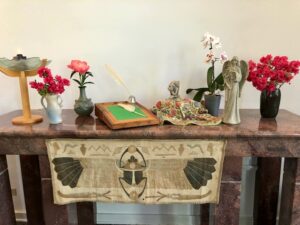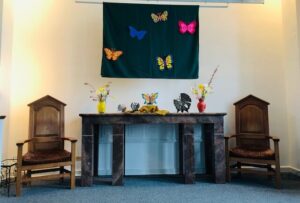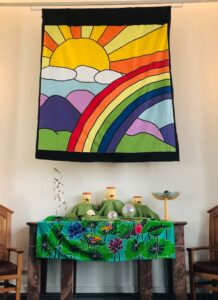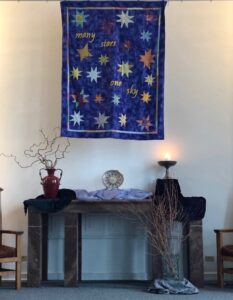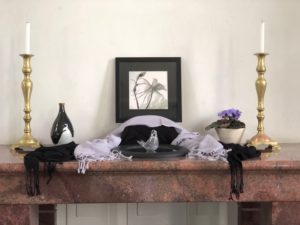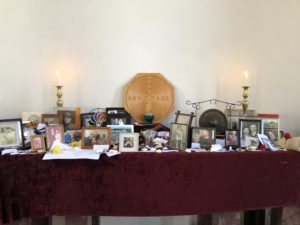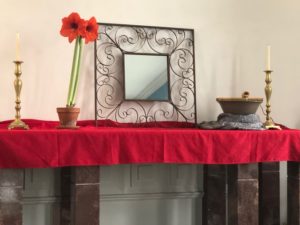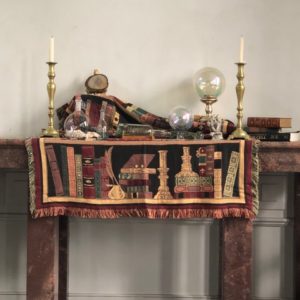A few weeks back I quietly celebrated one of the high holy days, if you will, of my own, personal liturgical calendar. August 8 marks the anniversary of an event that took place in 1974 – a young, French wire walker named Phillipe Petit strung a cable between the north and south towers of the World Trade Center. At approximately 7:00 am, Petit stepped out onto his wire and began to walk – or “dance” as it was described at the time by one of the Port Authority cops who was sent to retrieve him. Roughly 1,400 feet – more than a quarter of a mile – above the sidewalks of lower Manhattan, Petit would “dance” on his wire for about 45 minutes, completing eight crossings, including, at one point, laying down on his back and saluting a passing seagull. He did this without a safety wire; he did this without any kind of net; he did this without … permission. This was, as you’d imagine, an entirely illegal act, and one which thoroughly captivated my imagination and enchanted my soul. Even all these years later I find it an achievement that fills me with a kind of reverence – that a person would dream of doing something so audacious, and that a person could do something so impossible.
Except … I’ve come to learn that it never happened. At least it never happened in that way. Most years I write a post for my blog on or about what I started calling International Phillipe Petit Danced Between the Towers Day. For International Phillipe Petit Danced Between the Towers Day in 2012, I wanted to use a photograph of Petit as a street performer. I discovered that the photographs had been taken by Jean-Louis Blondeau, one of Petit’s closest friends at the time, and one of Petit’s accomplices in le coup. I tracked down his email address, and sent off a letter telling him of my admiration for Petit’s walk all those years ago, and asking his permission to use the photograph.
To my great pleasure – and surprise, actually – Jean-Louis wrote back. He said that I could use the image under three conditions: first, that I give him credit; second, that I provide a link to his website for the rest of his really rather remarkable work as a photographer; and, three, that he be able to have a look at what I was going to tell. You see, it turns out that the story I had loved for so long was really more of a myth or, as Jean-Louis called it, “a fairy tale made up by Phillipe.”
I should not have been surprised really. Myths – especially, perhaps, myths in Western cultures – love the lone hero. Our limelight seems to be so narrow as to only be able to encompass a person, one singular person, an individual with great courage, or wisdom, or passion, or vision, or audacity, or determination and grit. Yet very few stories really are about an individual hero. (Even my beloved Batman has always had at least Alfred and Commissioner Gordon by his side!) The story of Phillipe Petit’s walk is no different.
The myth is that Phillipe Petit strung a wire in the early hours of Thursday the 6th, but of course he didn’t. It took a team to get that inch-thick cable across that 138 ft gap space between the towers and, again, it isn’t true that Petit had this dream of walking at the top of the world and made it into a reality. That, too, took a team. Petit was, as I have come to understand it, too much of a dreamer, a visionary, an artist, if you will, to work out the mundane details of le coup. Petit famously answered the question of why he’d do something so audacious by saying, “Why? There is no why.” Well, there may have been no why, but there had to be a how, and it was Petit’s dear friend Jean-Louis who largely worked out that how.
But this is not a story of two people who, against all odds, performed something of a miracle. Again, a whole team was needed, a team that grew of necessity but which had at its core Jean-Louis, Jean François Heckel, Annie Allix, Jim More, Jean-Pierre Dousseau, and Barry Greenhouse. The story I had been so inspired by turns out to have been even more inspiring, because it is the story of a community making the impossible possible. Jean-Louis says that he has been working off-and-on on a book about the true story of le coup, and I can’t wait to read it. (Although he has told me not to hold my breath, as these things take time, and, after all, that day in ’74 is far from the only thing in his life. As I said, his photography is really amazing.)
Why am I taking all of this time telling this story? Take a look at the cover of your order of service. You may have seen this image before, but I know you know what it’s a picture of. There is the Rev. Dr. Martin Luther King, Jr., standing before the crowd of more than 200,000 people who gathered in Washington, D.C. on August 28, 1963 for the March on Washington for Jobs and Freedom. It is here that he delivered his famous “I Have a Dream” speech, and it is from this pulpit that he changed the course of our nation’s history.
Except, of course, that this didn’t happen either. At least it didn’t happen in this way. King was not the only person at that dias that day. Marian Anderson, Odetta, Joan Bayez, and Bob Dylan sang; Daisy Lee Bates spoke, Bates being a civil rights activist who, among other accomplishments, had advised the Little Rock Nine who desegregated the schools in Little Rock back in 1957 (and who was the only woman to speak that day). Also speaking that day were the actors Ossie Davis and Ruby Dee; the president of the NAACP, Roy Wilkins; the march organizer Baynard Rustin; the president of the American Jewish Congress, Rabbi Joachim Prinz; Whitney Young, president of the National Urban League (and Unitarian Universalist); and SNCC leader John Lewis. And there were others. My point is that, once again, what a number of people did has been mythologized as largely the accomplishment of a person, one singular person, an individual with great courage, wisdom, passion, vision, audacity, determination, and grit.
Yet even that is not what Paul Harvey used to call, “the rest of the story.” More than 200,000 people filled the National Mall to overflowing that day. And hundreds of thousands more had been part of the struggle for civil rights and the liberation of African Americans and it was they – all of them – who changed the course of our nation’s history. I have a book in my office titled Putting the Movement Back intoCivil Rights Teaching: a resource guide for classrooms and communities. Wendy Puriefoy, President of the Public Education Network has this to say about the book:
Civil rights teaching should lift up extraordinary leaders whose personal courage and sacrifice transformed our nation and our history. But it should also recognize the thousands of other acts of resistance and civil disobedience – by neighbors, grandmothers, youth, and everyday heroes – that created an unstoppable tidal wave of ethical conscience and human profess. Putting the Movement Back into Civil Rights Teaching is a unique collection of urgent voices who remind us that true and lasting movements for social, economic, and racial justice begin with you and me.”
You and me. You and me. Ordinary people doing mostly ordinary things. Just this morning a dear old friend sent me an extremely synchronistic text. She said that she “[has] not marched in Washington or NYC or Boston … [but] thinks the seemingly [unimportant] little things we do in our everyday, normal life are actually exactly what we need to do.” We do, of course, need people who show up at the front lines, as it were. We do. Yesterday, in Boston, roughly 40 members of the Klu Klux Klan had a rally on the Boston Commons. They were met by an estimated 20,000 people. That comes out to around 500 people per Klan member. It is essential that people show up.
And people sure did show up last weekend here in Charlottesville. And a good number of them were Unitarian Universalists from around the country, including some high-powered folks like Susan Frederick-Gray, the newly elected president of our Association. And last week they received some praise and appreciation, along with some of the leadership of our congregation. Yet no one should be fooled into thinking that they are what made the difference last Saturday. Thousands of people showed up downtown. Many, many people from this congregation showed up last Saturday. All were willing to put their lives on the line for what Christina likes to call, “our mutual liberation.” Just going out that day was putting your life on the line – the risk of arrest and of violence were real and ever-present.
And folks showed up in all sorts of ways. Some were at Emancipation involved in direct action or public witness; some were at McGuffy Park demonstrating in a different way; some staffed the legal hotline; some distributed water and snacks; some donated that water and those snacks; some provided first aid assistance, or helped clear the way for ambulances and medical personnel when needed; some were here, holding a safe and sacred space for anyone who needed it (and over the course of the day there were several people who needed it); some coordinated home hospitality for out-of-town and out-of-state guests (both UUs and non-UUs who answered the call to come); some opened their homes to provide that hospitality; some stayed home and intentionally put in time learning more about white supremacy; some stayed home and intentionally played with their kids extra hard, or did something special with their partner, their spouse, the dearest friends, so as to put a little more love out into the world on a day so filled with hate. Some did those little “unimportant” everyday, normal things we do, and made sure to do them with great love. So many people showed up in so many ways.
And our Racial Justice Committee, and before it the Undoing Racism Committee, have been showing up for years now – decades – laying the foundations for the understandings necessary for especially those of us who identify or are identified as white to show up. Even here, among us well-meaning and large-hearted, liberal, sometimes progressive Unitarian Universalists at times our limelight is too small. The true story, the truly powerful story, the “rest of the story” is that it took all of us who showed up, and all of us continuing to show up, to show that hate and bigotry will not be the last word. Domestic terrorism, white supremacist terrorism, will not win the day. Love will. Love will.
The social activist Dorothy Day once wrote:
People say, what is the sense of our small effort. They cannot see that we must lay one brick at a time, take one step at a time. A pebble cast into a pond causes ripples that spread in all directions. Each one of our thoughts, words and deeds is like that. No one has a right to sit down and feel hopeless. There’s too much work to do.
What is the sense of our small effort? Those small efforts, joined with the small efforts of others, can change the world. We need those leaders on whom the spotlight shines. After all, if Phillipe Petit hadn’t stepped out onto that wire 43 years ago, all of the planning and hard work done by Jean-Louis, François, Annie, Jim, Jean-Pierre, Barry, and others would not be remembered. Yet it is equally true that without their efforts, Petit’s walk would not even have been possible.
One last thought. Even a leader like the Rev. Dr. Martin Luther King, Jr. was not always the heroic, legendary figure “the Rev. Dr. Martin Luther King, Jr.” One of my favorite books about the civil rights era is actually a children’s book – My Brother Martin by Christine King Farris. And I love it because only two pages of it have anything to do with the famous Rev. Dr. King. The rest of it is about a boy named Martin – M.L to his family. It turns out that the Rev. Dr. Martin Luther King, Jr. was not always the Rev. Dr. Martin Luther King, Jr. He was, as we are, just a person who showed up.
So … for all of you who showed up, and all of those who showed up (but just not this morning), thank you. Thank you.
Yet our work has not ended; there’s too much work to do for us to rest too long. Yet let usnever forget that we need not do this work alone. In fact, we can’t it takes all of us. You and me. All of us.
Pax tecum,
RevWik
P.S. — some years ago I stopped calling the “holy day” I celebrate on August 6th, “International Philippe Petit Danced Between the Towers Day.” I used that old name in this sermon because, well, it sounds so formal and, to be honest, I thought its repetition would be a little humerous. After my early exchanges with M. Blondeau I have been calling it, more simply, Dance Between the Towers Day.


